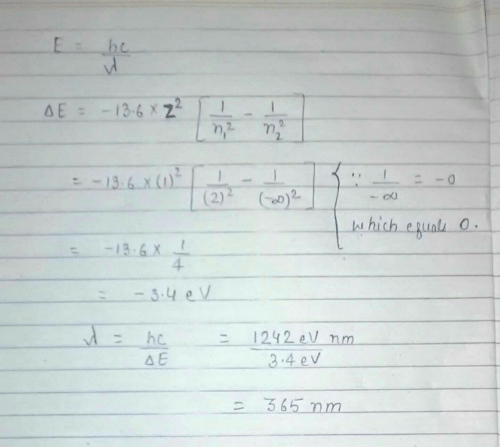NEET Exam > NEET Questions > The wavelength of radiation required to remov...
Start Learning for Free
The wavelength of radiation required to remove the electron of hydrogen atom from n=2 orbit to n=-∞ is?
Most Upvoted Answer
The wavelength of radiation required to remove the electron of hydroge...
Wavelength of Radiation Required to Remove Electron from Hydrogen Atom
Hydrogen atom consists of one proton and one electron. The electron revolves around the proton in different energy levels or orbits. The energy of the electron is quantized, i.e., it can only have certain discrete values. When an electron absorbs a photon, it can jump from a lower energy level to a higher energy level. Similarly, when an electron emits a photon, it can jump from a higher energy level to a lower energy level.
Energy Levels of Hydrogen Atom
- The energy levels of a hydrogen atom are given by the formula:
- En = -13.6/n2 eV
- where n is an integer and En is the energy of the nth energy level. The energy levels are arranged in such a way that the energy of the electron decreases as the value of n increases.
Transition of Electron from n=2 to n=-∞
The wavelength of radiation required to remove the electron from the n=2 orbit to n=-∞ is the wavelength of the photon emitted when the electron jumps from n=2 to n=-∞. When the electron jumps from n=2 to n=-∞, it emits a photon of a certain wavelength. The energy of the photon is equal to the difference in energy between the two energy levels:
- E2 - E-∞ = -13.6/22 - 0 = -3.4 eV
where E2 is the energy of the n=2 level and E-∞ is the energy of the electron when it is completely removed from the atom.
Calculation of Wavelength
The energy of a photon is given by the formula:
- E = hc/λ
where h is the Planck's constant (6.626 x 10-34 J s), c is the speed of light (3 x 108 m/s), and λ is the wavelength of the photon.
Substituting the values, we get:
- λ = hc/E = (6.626 x 10-34 J s x 3 x 108 m/s)/(-3.4 eV x 1.602 x 10-19 J/eV) = 1.21 x 10-7 m
Therefore, the wavelength of radiation required to remove the electron from the n=2 orbit to n=-∞ is 1.21 x 10-7 m.
Community Answer
The wavelength of radiation required to remove the electron of hydroge...

Attention NEET Students!
To make sure you are not studying endlessly, EduRev has designed NEET study material, with Structured Courses, Videos, & Test Series. Plus get personalized analysis, doubt solving and improvement plans to achieve a great score in NEET.

|
Explore Courses for NEET exam
|

|
Similar NEET Doubts
The wavelength of radiation required to remove the electron of hydrogen atom from n=2 orbit to n=-∞ is?
Question Description
The wavelength of radiation required to remove the electron of hydrogen atom from n=2 orbit to n=-∞ is? for NEET 2024 is part of NEET preparation. The Question and answers have been prepared according to the NEET exam syllabus. Information about The wavelength of radiation required to remove the electron of hydrogen atom from n=2 orbit to n=-∞ is? covers all topics & solutions for NEET 2024 Exam. Find important definitions, questions, meanings, examples, exercises and tests below for The wavelength of radiation required to remove the electron of hydrogen atom from n=2 orbit to n=-∞ is?.
The wavelength of radiation required to remove the electron of hydrogen atom from n=2 orbit to n=-∞ is? for NEET 2024 is part of NEET preparation. The Question and answers have been prepared according to the NEET exam syllabus. Information about The wavelength of radiation required to remove the electron of hydrogen atom from n=2 orbit to n=-∞ is? covers all topics & solutions for NEET 2024 Exam. Find important definitions, questions, meanings, examples, exercises and tests below for The wavelength of radiation required to remove the electron of hydrogen atom from n=2 orbit to n=-∞ is?.
Solutions for The wavelength of radiation required to remove the electron of hydrogen atom from n=2 orbit to n=-∞ is? in English & in Hindi are available as part of our courses for NEET.
Download more important topics, notes, lectures and mock test series for NEET Exam by signing up for free.
Here you can find the meaning of The wavelength of radiation required to remove the electron of hydrogen atom from n=2 orbit to n=-∞ is? defined & explained in the simplest way possible. Besides giving the explanation of
The wavelength of radiation required to remove the electron of hydrogen atom from n=2 orbit to n=-∞ is?, a detailed solution for The wavelength of radiation required to remove the electron of hydrogen atom from n=2 orbit to n=-∞ is? has been provided alongside types of The wavelength of radiation required to remove the electron of hydrogen atom from n=2 orbit to n=-∞ is? theory, EduRev gives you an
ample number of questions to practice The wavelength of radiation required to remove the electron of hydrogen atom from n=2 orbit to n=-∞ is? tests, examples and also practice NEET tests.

|
Explore Courses for NEET exam
|

|
Suggested Free Tests
Signup for Free!
Signup to see your scores go up within 7 days! Learn & Practice with 1000+ FREE Notes, Videos & Tests.

























